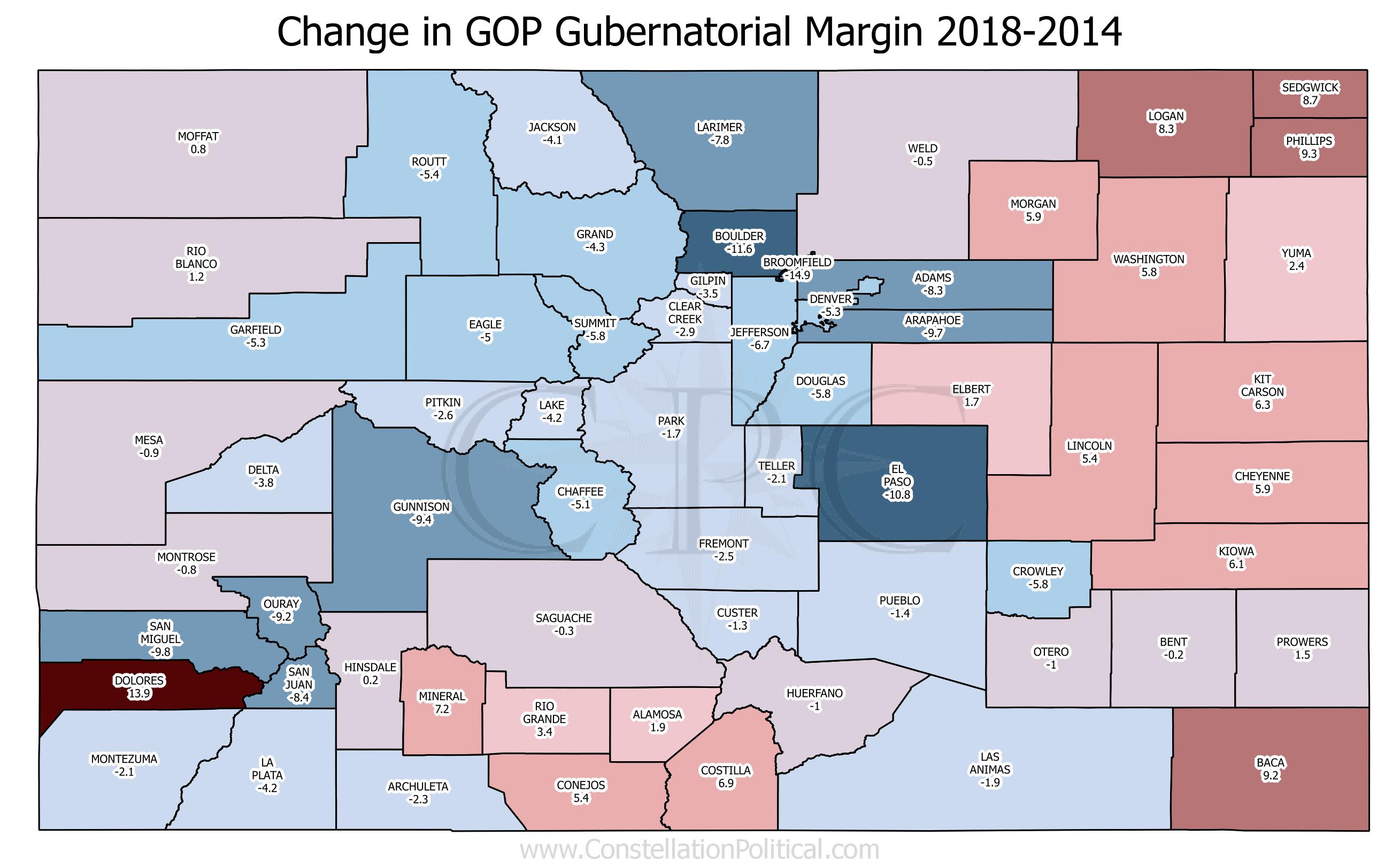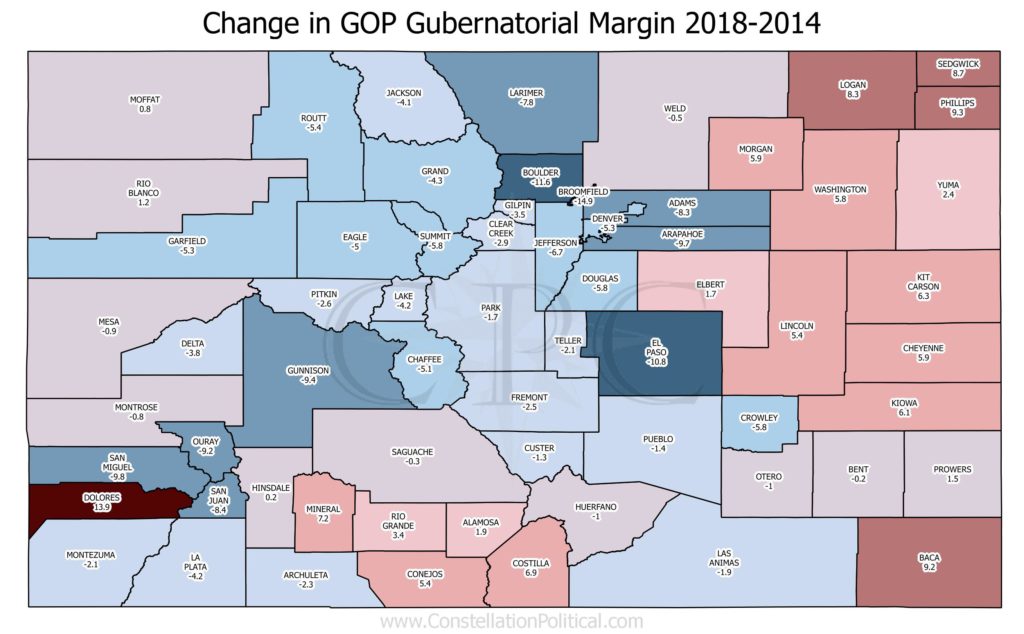 Different Story, Same Ending
Different Story, Same Ending
The latest round of post-election analysis included some sobering statistics for Colorado Republicans. But it also included two of my biggest pet peeves, and I just cannot stand to leave them unaddressed any longer so, before my usual ominous warning, we’re going to start with some points on psephology.
Westword’s Chris Bianchi penned an article looking at the four counties that switched from Trump to Polis. While interesting, he makes two common analytical errors that drive me bonkers.
You cannot compare Presidential elections to Mid-term elections.
You cannot compare raw vote counts across times and geographies
Unlike Comparisons
The first point should go without saying, but in the past month I’ve read a surprising amount of analysis that makes this comparison. Presidential and Mid-term elections are inherently different. A broader group of people tend to vote in Presidential elections. It’s why you see a consistent drop-off in turnout during Mid-term elections.
Turnout in 2012 was 15 points higher than in 2010, and turnout in 2016 was 18 points higher than in 2014. These represent huge swings in the raw number of votes cast.
This makes sense as there is a lot more interest in Presidential elections because national stories and the 24-hour cable news cycles dominate Presidential elections in a way that doesn’t happen locally. If this isn’t making intuitive sense to you, ask yourself: How many times did you see Treasurer Stapleton or Governor Polis on CNN or Fox News in the past six months?
Consider this raw vote comparison that Mr. Bianchi makes:
“In El Paso County, the GOP lost more than 25,000 votes in this year’s governor’s race from their 2016 presidential performance there, by far the most of any county statewide.”
This statement is the same as saying:
“In Wyoming, the GOP gubernatorial candidate received 944,389 fewer votes in this year’s governor’s race than did Walker Stapleton.”
or
“In El Paso County, the GOP gained more than 40,000 votes in this year’s governor’s race from their 2002 gubernatorial performance there.”
Both of the above statements are true, and yet, both are completely worthless from an analytical perspective. The above examples are trying to create two things as equal that have no logical commonalities. You would expect to see differences in the raw number of votes cast because the number of voters is different as well. And of course you would expect changes in El Paso to be the largest statewide because it has, by far, the most Republican voters of any county.
Consider another assertion that Mr. Bianchi makes:
“Another particularly troubling spot for Republicans came in Mesa County, another GOP stronghold and home to Grand Junction, a large Republican hub. Stapleton comfortably won here, taking Mesa by more than 25 percent. But Trump won by 36 percent in 2016, and it moved blue by more than 10 points from 2016 to 2018. A total of 10,730 votes moved in Democrats’ direction here, the fourth-highest raw vote swing among Colorado’s 64 counties.”
In 2016 Hillary Clinton received 21,729 votes in Mesa County, in 2018 Jared Polis received 23,873. That’s 2,144 votes moving in the Democrat’s direction, not 10,730. Just because Walker Stapleton lost votes doesn’t mean Governor Polis gained them. Some of those votes simply vanish because not as many people voted in 2018. That’s why you can’t compare raw vote counts across election cycles.
When discussing election results you need to compare the percentage of the vote that a candidate received or, better yet, the point differential between the candidates. This is how you correct for the above error in the Mesa County vote math.
Mr. Bianchi does look at the point differential in his analysis and where he does so he comes up with some interesting results. But you should read those for yourself in his story while I address some of the more nuanced points in his analysis.
Campaign Asymmetry
Beyond the above, I would also argue that using Treasurer Stapleton’s results as the proxy for GOP fortunes around the state is misguided. This was the most financially lopsided gubernatorial race that we’ve ever seen. On the hard money side, Governor Polis spent $24 mln to Treasurer Stapleton’s $4 mln. Faced with odds like that, it’s amazing the margin wasn’t even wider.
A better race to use as a comparison would be George Brauchler’s race for Attorney General. This was also a surprisingly expensive and engaging race by historic standards, but it was much more competitive.
Using the gubernatorial race, Mr. Bianchi attempts to make the point that the Democrat landslide wasn’t wholly the result of their performance in their metro-Denver stronghold:
“Consider this: If you got rid of Denver County and neighboring population-rich Broomfield, Adams and Arapahoe counties’ collective votes, Stapleton still would’ve lost.”
However, getting rid of Denver County alone would have meant that George Brauchler would have won his race.
Like Comparisons
Now, let’s revisit a particularly surprising claim that Mr. Bianchi makes:
“…the place where Republicans probably did the worst was in the heart of their home turf: Colorado Springs.”
Using Mr. Bianchi’s own analysis doesn’t yield this result. He correctly notes that President Trump defeated Clinton in El Paso by 22 points in 2016, while Treasurer Stapleton only won El Paso by 17 points this year — for a six point deterioration in the Republican margin. But that margin deteriorated by even more in Jefferson, Pueblo, Broomfield, Larimer and Mesa Counties. El Paso wasn’t close to being the worst. Unless of course…

One were to make like comparisons. And since the more proper electoral comparison to make would be to compare two gubernatorial races in two mid-terms, I’ve done just that.
The above map shows the 2014 GOP gubernatorial point differential subtracted from the 2018 GOP gubernatorial point differential. For example; in Broomfield County in 2018 the Republican gubernatorial candidate received 22 fewer points than the Democrat, while in 2014 the Republican received seven points fewer. That’s a deterioration of 15 points.
The good news is Republicans have not seen the greatest deterioration in our base county of El Paso. …it comes in third behind Broomfield and Boulder. Here is the change in gubernatorial margin for the top 12 counties:

Even more sobering is this tidbit; Republican’s average county margin in the 2018 gubernatorial race was only 1.3 points worse than in 2014. That means that Republicans made marked gains in many counties. And you can see that on the right-hand side of the above map. But, all the voters live in the 12 counties in the above table.
But On the Bright Side
The slide in Republican performance that we’ve been witnessing is not because of a mass abandonment of the party. As I discuss in my look at performance among Unaffiliated voters this cycle, we aren’t necessarily losing ground. It’s that the Democrats are making up much more ground than we are. As I’m constantly pointing out, Unaffiliated registration has exploded, and those new voters are breaking towards Democrats. At the same time, Democrats have taken a sustained registration lead over Republicans for the first time ever.
We need not wait to tackle either of these problems.
